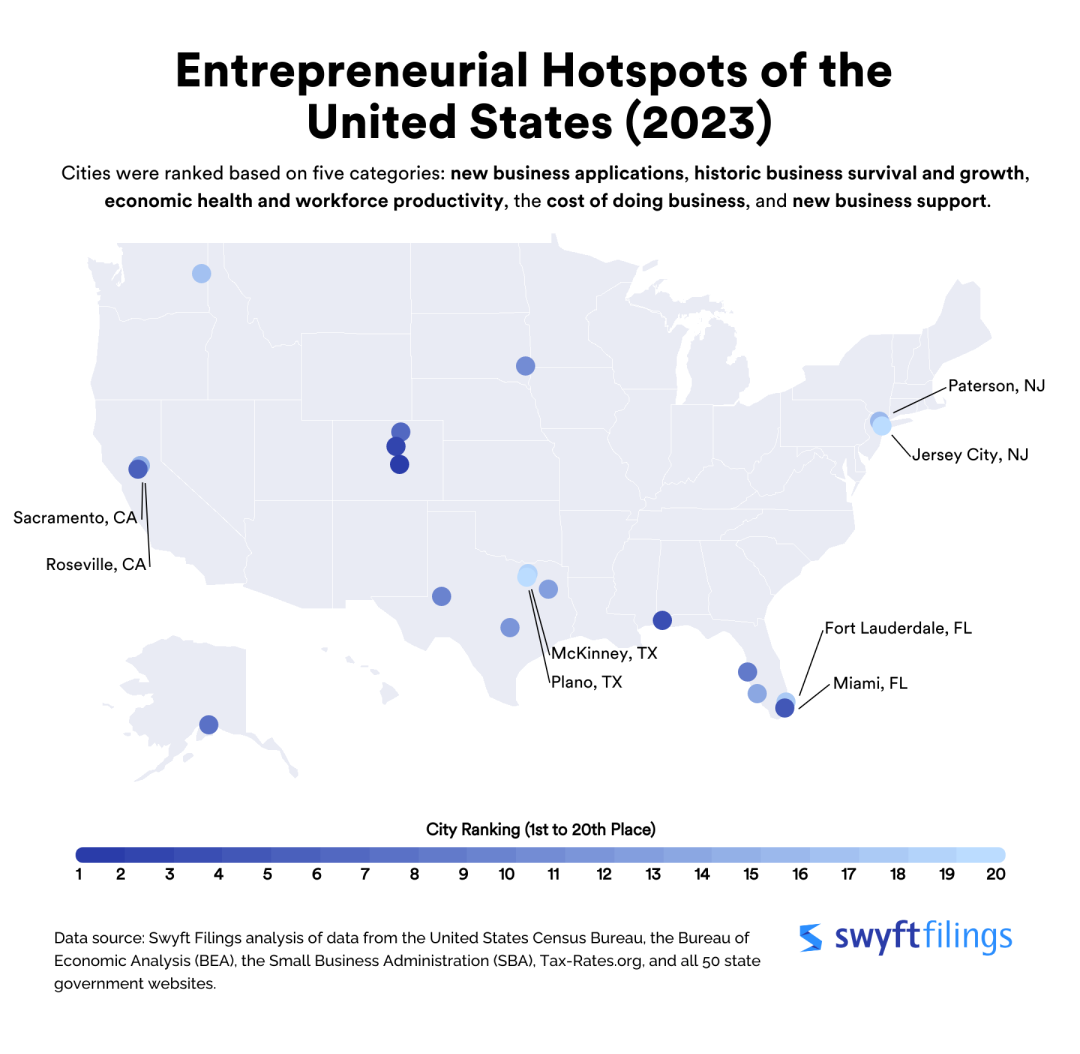Entrepreneurship hotspots of the United States: The top cities encouraging new business growth

Canva
Entrepreneurship hotspots of the United States: The top cities encouraging new business growth
Two people smiling in a small warehouse surrounded by boxes.
Entrepreneurship often thrives in places that offer the right mix of resources, support, and market opportunities. In regions with a strong or growing economy, businesses have the opportunity to connect with a broad customer base and recruit top-tier talent, amplifying their growth potential. Certain locales also nurture a more business-friendly environment through lower operating costs, including taxes, wages, and rent, and supportive legislation.
This year, traditional powerhouses such as New York City, San Francisco, and Boston did not feature among the top 20. While these cities have historically been known for their vibrant startup cultures, high tax rates and business operating costs may have deterred new ventures, particularly for San Francisco and Boston (which experienced an 11% and 13% drop in new business applications from 2021 to 2022, respectively). Instead, several mid-sized cities with fewer than 250,000 residents made the list. This trend underscores the notion that a sprawling metropolis isn’t a prerequisite for new business success. In fact, less populous cities offer their own unique advantages, such as lower costs and a tightly-knit community, which can be vital for businesses in their early stages.
To identify the top cities fostering new business growth in 2023, the data and research team at Swyft Filings turned to the most recent data from the United States Census Bureau, the Bureau of Economic Analysis (BEA), and other government sources. They evaluated the 300 most populous cities in the U.S. on key factors such as the rate of new business formations and business climate favorability.
Without further ado, here are the top 20 cities whose residents are the most likely to have brought their business ideas to life, and where the business environment is best positioned to foster long-term success.
![]()

Swyft Filings
Key findings
A map of the U.S. showing top hotspots for entrepreneurship in 2023.
– National averages: In 2022, about 1.5% of the population, or 15 out of every 1,000 people, applied for a new business. Despite this substantial figure, business applications in the United States declined overall between 2021 and 2022 by 6.24%.
– Regional differences: Regional disparities are evident when examining new business applications per capita in 2022 and the year-over-year change in these applications. The South exhibits the highest rate of new business applications per capita, with 18 for every 1,000 residents, on average. On the other hand, the West, Northeast, and Midwest present lower rates of 14, 13, and 12 applications per 1,000 residents, respectively. In terms of yearly change from 2021 to 2022, all regions experienced a decrease in new business applications. The West saw a dip of just 1.96%, while sharper declines were observed in the Northeast (6.06%), the South (7.64%), and the Midwest (7.79%).
– Tax rates and new business applications are inversely related: An analysis of new business applications per capita in 2022 across the 300 most populous cities in the U.S. revealed a low inverse correlation with personal income tax, corporate income tax, and state sales tax rates in those cities, Pearson’s r = -0.25, -0.15, and -0.16, respectively. While these findings provide an interesting correlation, it’s important to remember that they do not demonstrate a direct cause-effect relationship.
Top cities encouraging business growth in 2023
20. Plano, Texas
– Population: 289,547
– Composite score: 53.17
– Business applications 1,000 residents, 2022: 20
– Change in business applications, 2021-2022: -2.30%
19. Jersey City, New Jersey
– Population: 286,670
– Composite score: 53.21
– Business applications per 1,000 residents, 2022: 19
– Change in business applications, 2021-2022: -2.94%
18. McKinney, Texas
– Population: 207,507
– Composite score: 53.23
– Business applications per 1,000 residents, 2022: 20
– Change in business applications, 2021-2022: -2.27%
17. Fort Lauderdale, Florida
– Population: 183,146
– Composite score: 53.38
– Business applications per 1,000 residents, 2022: 39
– Change in business applications, 2021-2022: -9.03%
16. Spokane, Washington
– Population: 107,325
– Composite score: 53.97
– Business applications per 1,000 residents, 2022: 13
– Change in business applications, 2021-2022: +1.82%
15. Paterson, New Jersey
– Population: 156,661
– Composite score: 54.22
– Business applications per 1,000 residents, 2022: 18
– Change in business applications, 2021-2022: -0.89%
14. Roseville, California
– Population: 154,817
– Composite score: 54.38
– Business applications per 1,000 residents, 2022: 11
– Change in business applications, 2021-2022: +3.88%
13. Cape Coral, Florida
– Population: 216,992
– Composite score: 54.60
– Business applications per 1,000 residents, 2022: 23
– Change in business applications, 2021-2022: +4.22%
12. Tyler, Texas
– Population: 109,286
– Composite score: 54.95
– Business applications per 1,000 residents, 2022: 14
– Change in business applications, 2021-2022: +4.71%
11. Austin, Texas
– Population: 974,447
– Composite score: 54.96
– Business applications per 1,000 residents, 2022: 23
– Change in business applications, 2021-2022: -1.57%
10. Sioux Falls, South Dakota
– Population: 202,078
– Composite score: 55.25
– Business applications per 1,000 residents, 2022: 14
– Change in business applications, 2021-2022: 1.26%
9. Midland, Texas
– Population: 134,444
– Composite score: 55.40
– Business applications per 1,000 residents, 2022: 20
– Change in business applications, 2021-2022: +1.36%
8. St. Petersburg, Florida
– Population: 261,256
– Composite score: 56.40
– Business applications per 1,000 residents, 2022: 27
– Change in business applications, 2021-2022: +3.69%
7. Anchorage, Alaska
– Population: 287,145
– Composite score: 56.60
– Business applications per 1,000 residents: 13
– Change in business applications, 2021-2022: +9.61%
6. Greeley, Colorado
– Population: 109,209
– Composite score: 58.43
– Business applications per 1,000 residents, 2022: 16
– Change in business applications, 2021-2022: +6.77%
5. Sacramento, California
– Population: 528,001
– Composite score: 58.75
– Business applications per 1,000 residents, 2022: 15
– Change in business applications, 2021-2022: +7.07%
4. Miami, Florida
– Population: 449,514
– Composite score: 59.57
– Business applications per 1,000 residents, 2022: 48
– Change in business applications, 2021-2022: -6.05%
3. Mobile, Alabama
– Population: 183,289
– Composite score: 59.86
– Business applications per 1,000 residents, 2022: 24
– Change in business applications, 2021-2022: +11.50%
2. Denver, Colorado
– Population: 713,252
– Composite score: 61.04
– Business applications per 1,000 residents, 2022: 29
– Change in business applications, 2021-2022: +1.11%
1. Colorado Springs, Colorado
– Population: 486,248
– Composite score: 63.63
– Business applications per 1,000 residents, 2022: 20
– Change in business applications, 2021-2022: +11.35%
Methodology
To identify the best cities for new businesses, the data and research team ranked the 300 most populous cities in the United States using a composite score of factors across five key dimensions: new business applications, historic business survival data, economic health and workforce productivity, the cost of doing business, and new business support.
New business applications: 50% of composite score
– New business applications as a percentage of the population (2022).
– Change in new business applications from 2021 to 2022.
Historic business survival data: 15% of composite score
– 1-year business survival rate.
– 5-year business survival rate.
– Average business size after 5 years.
Economic health and workforce productivity: 15% of composite score
Cost of doing business: 10% of composite score
– Regional price parity data by state and metro area.
– Personal income tax rate, from state government websites.
– Corporate income tax rate, from state government websites.
– State sales tax rate.
New business support via SBA loans: 10% of composite score
– SBA 7(a) loans: average dollar amount per loan.
– SBA 7(a) loans: private lenders per capita.
– SBA 7(a) loans: loans granted per capita.
Some data were available only at the state level and not at the city level. This means that each city was either helped or harmed by the business environment within its state.
The methodology used to approximate new business applications per 1,000 residents, along with the change in these applications between 2021 and 2022 at the city level, relied on county-level business application data and population statistics. The data and research team derived the rate of new business applications per 1,000 residents for each county by dividing the number of new applications by the county’s population.
When considering cities that spanned multiple counties, they implemented a weighted average method. The weighting took into account the proportion of the city’s population that came from each corresponding county. This approach offered a more accurate city-level approximation by representing the mixed population sources of these cities.
This story was produced by Swyft Filings and reviewed and distributed by Stacker Media.